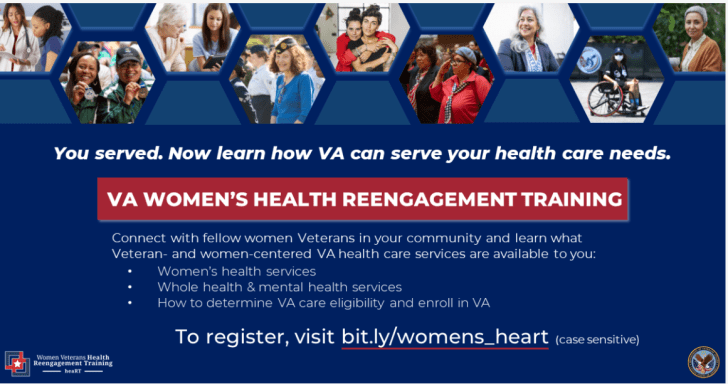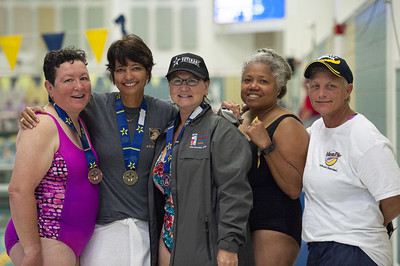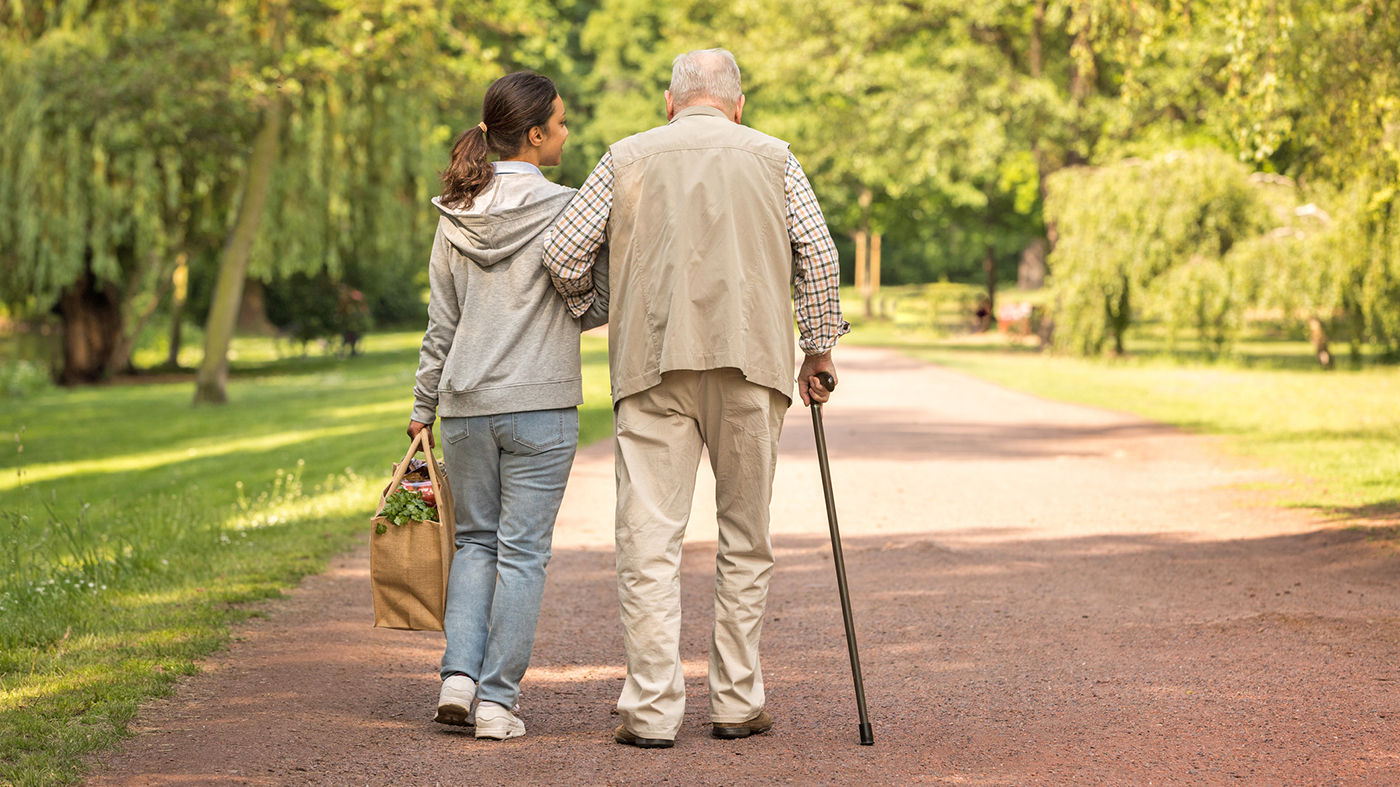The VA Women’s Health Reengagement Training (heaRT) Team is on a mission to share information on women’s health services available at VA.
VA Women’s heaRT discusses how to apply for and use VA health care to educate women Veterans on the VA health care they earned and deserve. Here are the seven things you need to know about the training:
1. VA Women’s heaRT is developed for women Veterans by women Veterans
VA is no longer “Your Grandfather’s VA.” As the needs of Veterans change and evolve, VA is committed to meeting those needs. The VA Women’s heaRT program was designed for women Veterans with input from women Veterans and in collaboration with VA subject matter experts to create a customized and personal training experience for all attendees.
2. All women Veterans are welcome!
All women Veterans, including women not enrolled in VA health care and women Veterans enrolled in VA health care but interested in learning more, are welcome to attend a VA Women’s heaRT session. No matter where you are on your VA health care journey, you will leave the VA Women’s heaRT session confident in your abilities to use the VA health care benefits you have earned.
3. VA Women’s heaRT is a necessary training for all women Veterans
Women Veterans are the fastest growing Veteran population and are projected to account for 2.2 million members of the Veteran population by 2026. Currently, only 44% of women Veterans are enrolled in VA health care, which is 8% lower than male Veterans. Women Veterans have unique physical, mental and spiritual needs that can be met through VA health care. Attending VA Women’s heaRT gives women Veterans the tools to navigate VA health care and seek support for their specific health care needs.
4. Women Veterans will leave VA Women’s heaRT with the skills to navigate VA health care
Through this one-time four-hour training session, women Veterans will learn how VA is structured, what women- and Veteran-specific health care services are available to them and how to enroll in VA health care. Each training session includes women Veterans who use VA health care and who is, in most cases, a Women Veteran Program Manager (WVPM) who can answer questions about how to seek specific health care services. The resources and women Veteran support do not stop at the end of the training; all participants leave the training session with the knowledge of how to contact their local WVPM and a handbook to help them enroll in and navigate VA health care.
5. VA Women’s heaRT is a safe community space for women Veterans
This women-only training prioritizes establishing a space where women can have personal conversations and connect over shared experiences. Participants are encouraged to share their thoughts and perspectives about their time in the military and seeking heath care after transitioning out of the military. Fellow participants said the training was “so informative” and that it was “good to be with other women who served and understand the nuances of the military.”
6. Training Sessions are accessible nationwide
The VA Women’s heaRT program is offering virtual and in-person training sessions this year. Forty sessions will be offered virtually and can be accessed from anywhere in the country. This season, five sessions will be offered in-person, with locations across the country, including Las Vegas; Tulsa, Arizona; Nashville, Tennessee; Sacramento, California; and Seattle. Training sessions are provided on many dates and times to accommodate various time zones and personal schedules.
7. Register for a training session on the VA Women’s HeaRT Website
Visit the VA Women’s heaRT website to register for a training session today!
Topics in this story
More Stories
Musicians On Call is hosting “Concert For Veterans,” a special virtual concert that bridges the gap between hospital walls and our nation's recognition of Veterans.
The American Red Cross Military and Veteran Caregiver Network provides caregivers with a variety of resources and support.
Hiring Our Heroes is saying thank you to America’s military by giving away a new Toyota to one lucky, active-duty service member, Veteran or military spouse.







I feel it’s about time! Hopefully, more specialized care and puzzeling specific women problems presented to VA care providers will be investigated more thoroughly and listened to for a diagnosis before saying the VA does not offer that to women veterans! Stop saying women veterans are ignorant or dont know! We’ve We’ve asked for help for years! We’re not being serviced like our counterpart!!!
BEWARE. Yes, they really need to educate women veterans before we use VA for our needs. I found out the hard way that basic “female services” are NOT COVERED like everything else under the “free after discharge for #X years” premise, and I was billed for services and medication (medication I specifically said I did NOT WANT – no pregnant horse urine is going up my HOO!). I appealed their decision, so I didn’t pay the bill. They denied the appeal, so I re-appealed. When I didn’t pay the bill, VA took it out of my US tax refund!! Here’s the best part: when VA finally completed processing my disability claim (3-4 yrs after initial filing), I was at 80%; they said I’d be reimbursed for any prior charges, BUT MY ACCOUNT (which we’re not allowed to see) SHOWS NONE!! So… USERS BEWARE!!!!!! I will not see them for anything female-oriented again, no sirree!! They apparently want to charge us up the HOO!! Be kind to your HOO and your wallet, take your HOO elsewhere.
I am interested in an in person training session only at the Fayetteville Arkansas VAMC.
Why are men veterans treated differently than women veterans? This is Discrimination to the very core of so-called equality. Women get special treatment. Women even have their own clinic that treats nonrelated military issues. like pregnancies, abortions, fertility treatment, etc. Heck, Women even get free birth control, sanitary napkins and Tampax. Male veterans do not get any free condoms, treatment for ED or low Testosterone treatment. The most that the VA does for Male Veterans is prescribe a half dozen Viagra and kick them out of the office. Viagra is not a miracle pill and don’t work for many males, but the treatment STOPS there. Where is the equality?
I had a mammogram in July 2022; the results came back that I needed a ultrasound on the left breast. Since Martinsburg VAMC uses Care in the Community, it took 55DAYS to get that ultrasound. A biopsy was needed, another 22 days. Since November 2022, I have had TWO lumpectomies and at this time, am having chemo. Bottom line, women VETS are forgotten. I am glad that I can advocate for myself, there are MANY who CAN’T.
There should be more locations for in-person training sessions. Not all of us have computers let alone the technological ability to use them
In paragraph 6 above concerning locations for trading is that supposed to read Tucson, Arizona vice Tulsa? Sounds like a very interesting program – thanks for the info.
These things sound so wonderful, but I’ve been retired long enough to know that the programs keep changing, people come and go, and at the end of the day, the care is only as good as the providers. Some places are great, others mediocre and some places are downright deplorable. So I’m not wasting 4 hours of my life to sit in on this “training”. I looked at the training material, and all I could do was roll my eyes. Where I live right now, the VA’s WHC clinic is like this course looks like – lots of talk and very little action. Why should I care when they don’t? I’d rather read a book or watch a movie to try to distract myself from my problems. It’s a lot more productive.
Hi, I have an interest in this program, but would really prefer to attend this in person. Any chance this will be scheduled in New York, at the Buffalo location ?
There was a time when I would have taken this class, but after going to the VA for nearly 30 years, I have experienced how the VA hires and incorporates policies that are not always to the benefit of the patient.
In the past 16 months I went to the women’s clinic as I was bleeding vaginally. At age 69, that is not normal. No physical exam occurred but options as to what could be causing the bleeding was given. If the bleeding got worse or continued I was told to go to the ER, which I did.
There I was asked a series of questions. The 2nd or 3rd was do you use toys? Being a bit confused I took a moment to try to understand the question when it hit me that the PA was asking about sex toys.
Guess I lead a boring life and said no.
Finally, I was referred to an excellent gynecologist who after attempting a D & C referred me to a hospital for a hysterectomy. Had there been a cancer, which the teaching hospital thought, the delay from the initial appointment with the womens clinic until surgery could allowed the cancer to grow.
As an adult with common sense, it seems a simple pelvic exam would have been very helpful when I first presented.
I wonder how often common sense is forgotten and ends up costing the VAMC much more than basic medical care.
Yep, I agree with you no common sense. It took me 9 months to get the VA to look at my husbands feed tube that was massively leaking even though I keep bringing him to the ED they did not call gastro, it wound up leading to my husbands death. I was just told I had to be wrong about the leaking and wrong later when his abdomen was so destroyed by his stomach acid that tube kept falling out. Yep no common sense, if it was a civilian emergency room they would have called gastro and set up a follow up with them.